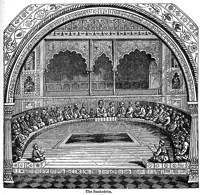Sanhedrin
Origin
Late Hebrew sanhedhrīn (gĕdhōlāh) (great) Sanhedrin, from Greek synedrion council, from synedros sitting in council, from syn- + hedra seat
Definition
- the supreme council and tribunal of the Jews during postexilic times headed by a High Priest and having religious, civil, and criminal jurisdiction
Description
The Sanhedrin (Hebrew: סַנְהֶדְרִין; Greek: συνέδριον,[1] synedrion, "sitting together," hence "assembly" or "council") was an assembly of twenty-three judges appointed in every city in the Biblical Land of Israel.
The Great Sanhedrin was the supreme court of ancient Israel made of 71 members. The Great Sanhedrin was made up of a Chief/Prince/Leader called Nasi (at some times this position may have been held by the Kohen Gadol or the High Priest), a vice chief justice (Av Beit Din), and sixty-nine general members. In the Second Temple period, the Great Sanhedrin met in the Hall of Hewn Stones in the Temple in Jerusalem. The court convened every day except festivals and Shabbat. In the late 3rd century, to avoid persecution, its authoritative decisions were issued under the name of Beth HaMidrash.
The last binding decision of the Sanhedrin was in 358, when the Hebrew Calendar was adopted. The Sanhedrin was dissolved after continued persecution by the Roman Empire. Over the centuries, there have been attempts to revive the institution, such as the Grand Sanhedrin convened by Napoleon Bonaparte.
The Sanhedrin is mentioned in the Gospels in relation to the Sanhedrin Trial of Jesus. [1]
